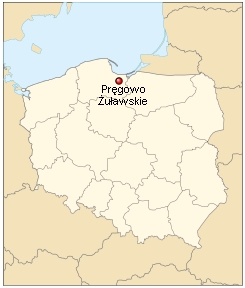Difference between revisions of "Prangenau (Pomeranian Voivodeship, Poland)"
| [checked revision] | [checked revision] |
m (Added categories and added image.) |
m |
||
| Line 10: | Line 10: | ||
The 1776 Prussian census lists nine Mennonite families in Prangenau with the following surnames: Claasen, Conrad, Dick, Ens, Kroecker, Regehr, Toews, and von Bargen. In 1820, the village had 188 residents, including 54 Mennonites. In 1869, the village had 303 residents, including 43 Mennonites. | The 1776 Prussian census lists nine Mennonite families in Prangenau with the following surnames: Claasen, Conrad, Dick, Ens, Kroecker, Regehr, Toews, and von Bargen. In 1820, the village had 188 residents, including 54 Mennonites. In 1869, the village had 303 residents, including 43 Mennonites. | ||
| − | Located in the area of the [[Ladekopp (Pomeranian Voivodeship, Poland)|Ladekopp]] community, it was rather late in receiving Mennonite settlers. Some of these settlers lived on the three farmsteads (Höfe) "built into the field." One of these farms belonged to Johann Penner | + | Located in the area of the [[Ladekopp (Pomeranian Voivodeship, Poland)|Ladekopp]] community, it was rather late in receiving Mennonite settlers. Some of these settlers lived on the three farmsteads (Höfe) "built into the field." One of these farms belonged to Johann Penner, the elder of the Ladekopp congregation until his death in 1943. Since he was also chairman of the Committee of Elders of the Conference of the Mennonite Churches of East and West Prussia, this village became one of the better-known villages. |
= Bibliography = | = Bibliography = | ||
"Familienforschung in Westpreußen." Hans-Jürgen Wolf. Web. 29 September 2012. [http://www.westpreussen.de/cms/ct/ortsverzeichnis/details.php http://www.westpreussen.de]. | "Familienforschung in Westpreußen." Hans-Jürgen Wolf. Web. 29 September 2012. [http://www.westpreussen.de/cms/ct/ortsverzeichnis/details.php http://www.westpreussen.de]. | ||
Revision as of 18:05, 10 August 2014

Source: Archiwum Map Zachodniej Polski
http://amzpbig.com/maps/1879_Gr_Lichtenau_1909.jpg.
Prangenau (also known as Prangau, Prągowo, Pręgowo, Pręgnowo; now known as Pręgowo Żuławskie; coordinates: 54.157224,18.929166 [54° 9' 26" N, 18° 55' 44" E]; population in 1905, 235; in 2006, 82), a village in the Marienburg Werder, West Prussia (now Poland). It lies approximately 6 kilometers (4 miles) north-west of Nowy Staw (Neuteich), 16 km. (10 mi.) north-west of Malbork (Marienburg), and 31 km. (19 mi.) south-east of the regional capital Gdańsk (Danzig).
Prangenau was established in 1350 by the Grand Commander, Heinrich Tusmer. A half-timbered Lutheran church was erected in Prangenau in 1768. Until 1772 Prangenau was part of the Kingdom of Poland. The First Partition of Poland in 1772 resulted in the creation of a new province in 1773, called West Prussia, in which Prangenau was located. Prangenau was situated in the district (Kreis) of Marienburg until the establishment of the Free City of Danzig in 1920. The village came under the control of Nazi Germany during World War II until February 1945, when it was occupied by Soviet forces and returned to Poland. In 2012 Prangenau (now Pręgowo Żuławskie) was a village in the administrative district of Gmina Nowy Staw, within Malbork County, Pomeranian Voivodeship.
The 1776 Prussian census lists nine Mennonite families in Prangenau with the following surnames: Claasen, Conrad, Dick, Ens, Kroecker, Regehr, Toews, and von Bargen. In 1820, the village had 188 residents, including 54 Mennonites. In 1869, the village had 303 residents, including 43 Mennonites.
Located in the area of the Ladekopp community, it was rather late in receiving Mennonite settlers. Some of these settlers lived on the three farmsteads (Höfe) "built into the field." One of these farms belonged to Johann Penner, the elder of the Ladekopp congregation until his death in 1943. Since he was also chairman of the Committee of Elders of the Conference of the Mennonite Churches of East and West Prussia, this village became one of the better-known villages.
Bibliography
"Familienforschung in Westpreußen." Hans-Jürgen Wolf. Web. 29 September 2012. http://www.westpreussen.de.
Hege, Christian and Christian Neff. Mennonitisches Lexikon, 4 vols. Frankfurt & Weierhof: Hege; Karlsruhe: Schneider, 1913-1967: v. III, 388.
Stowarzyszenie Konserwatorów Zabytków. "Stara Koscielnica." Catalogue of Monuments of Dutch Colonization in Poland. 2005. Web. 17 October 2012. http://holland.org.pl/art.php?kat=obiekt&id=421&lang=en.
Wikipedia. "Pręgowo Żuławskie." Web. 17 October 2012. http://en.wikipedia.org/wiki/Pręgowo_Żuławskie.
Maps
Map:Pręgowo Żuławskie (Pomeranian Voivodeship, Poland)
| Author(s) | Horst Quiring |
|---|---|
| Richard D. Thiessen | |
| Date Published | October 2012 |
Cite This Article
MLA style
Quiring, Horst and Richard D. Thiessen. "Prangenau (Pomeranian Voivodeship, Poland)." Global Anabaptist Mennonite Encyclopedia Online. October 2012. Web. 22 Nov 2024. https://gameo.org/index.php?title=Prangenau_(Pomeranian_Voivodeship,_Poland)&oldid=123957.
APA style
Quiring, Horst and Richard D. Thiessen. (October 2012). Prangenau (Pomeranian Voivodeship, Poland). Global Anabaptist Mennonite Encyclopedia Online. Retrieved 22 November 2024, from https://gameo.org/index.php?title=Prangenau_(Pomeranian_Voivodeship,_Poland)&oldid=123957.
Adapted by permission of Herald Press, Harrisonburg, Virginia, from Mennonite Encyclopedia, Vol. 4, p. 210. All rights reserved.
©1996-2024 by the Global Anabaptist Mennonite Encyclopedia Online. All rights reserved.

